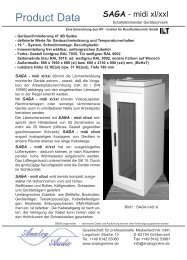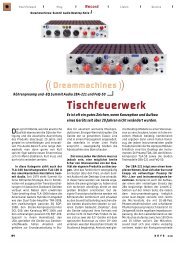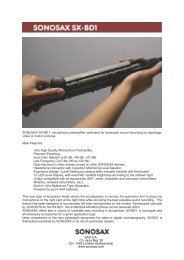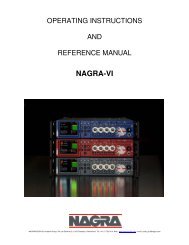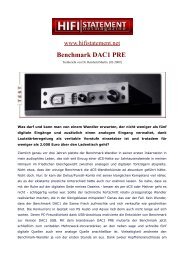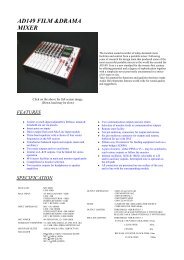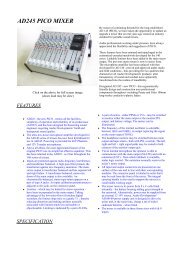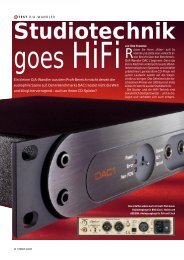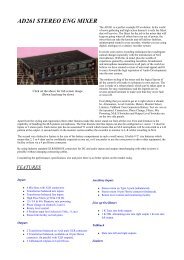AD147 MERCURY MIXER - Analog Audio Gmbh
AD147 MERCURY MIXER - Analog Audio Gmbh
AD147 MERCURY MIXER - Analog Audio Gmbh
Create successful ePaper yourself
Turn your PDF publications into a flip-book with our unique Google optimized e-Paper software.
<strong>AD147</strong> <strong>MERCURY</strong> <strong>MIXER</strong><br />
FEATURES<br />
Click on the above for full screen image.<br />
(Down load may be slow)<br />
� The <strong>AD147</strong> addition to the 140 series of mixers uses the<br />
same ultra low noise circuitry and customized aluminum<br />
extrusions that have rightly earned for the range its<br />
reputation for clean, crisp audio and reliability.<br />
� The <strong>AD147</strong> has been developed for discerning engineers<br />
who require <strong>Audio</strong> Developments' build and transparent<br />
sound quality allied with the simplicity of its predecessor<br />
- PICO.<br />
� The <strong>AD147</strong> incorporates the M-S facilities that are now<br />
much appreciated by <strong>Audio</strong> Developments' customers.<br />
Many recordists are aware of the advantages Blumlein's<br />
M-S microphone techniques have over all other<br />
microphone techniques - even when recording in the L-R<br />
domain.<br />
� The <strong>AD147</strong> has four mixing busses that enable mixing<br />
and/or recording to be performed in the L-R and M-S<br />
domains simultaneously. Matrix amplifiers may be<br />
switched into the main L-R output and across auxiliary 1<br />
& 2 outputs.<br />
� The <strong>AD147</strong> takes advantage of the lower noise-floor of<br />
modern digital recorders - the limiter slope ratio is a<br />
gentle 7:1, thereby reducing distortion and making the<br />
artifacts normally associated with limiters much less<br />
noticeable or objectionable.<br />
SPECIFICATION<br />
MAX GAIN MIC 85dB<br />
LINE 50dB<br />
MAX. INPUT AT MAX GAIN MIC -42dB<br />
LINE -7dB<br />
INPUT IMPEDANCE<br />
MIC >2k OHMS<br />
Continuing on from the enormous success of the AD146, 4<br />
output Portable Mixer the design concept of the <strong>AD147</strong> was<br />
to give a choice of formats whilst maintaining the same<br />
high quality of build, components and performance.<br />
The output section has been divided into 2 main groups<br />
controlled by full length linear faders and 2 Auxiliary Sends<br />
using Rotary Controls.<br />
Pan Pots route the main Signal path while the Auxiliaries<br />
have individual level controls which are switchable between<br />
Pre and Post the Channel Fader and can also be switched<br />
completely out of circuit. This feature means that the mixer<br />
can also be used as a quasi 4 group unit.<br />
By using an electronically balanced midline inputs and<br />
outputs there is a significant cost / weight benefit. Further<br />
savings in the build method result in an overall cost<br />
reduction of 20-25% on the equivalent frame size of the AD<br />
146.<br />
Many other features that have made the AD146 so popular<br />
are also included in this addition to the <strong>Audio</strong><br />
Developments family.<br />
� The <strong>AD147</strong> presents all its input and output connectors<br />
on one surface of the case and in-line with the<br />
corresponding module. The connector panel is labeled in<br />
order that it may be read from the front of the mixer. The<br />
integral carrying handle may also be used to support the<br />
mixer at a comfortable working angle.<br />
� The <strong>AD147</strong> inputs, main and auxiliary outputs are<br />
electronically balanced on XLRs with an option of<br />
transformer balancing on outputs. Separate connectors are<br />
used for microphone and line-level inputs: such is the<br />
isolation, both input signals may remain connected at all<br />
times. Monitor left, right and headphones together with<br />
stereo auxiliary return left and right appear on standard<br />
jacks. A 6-pin XLR carries two-way conversation<br />
between the mixer and an Outstation - boom operator,<br />
director etc.<br />
� The <strong>AD147</strong> receives its power from 10 x C cells fitted<br />
internally - the battery housing adding great strength to<br />
the casework. Alternatively, the mixer may be powered<br />
from an external 12-15v DC source. <strong>Audio</strong><br />
Developments' AD100-09 power supply unit is designed<br />
to drive the mixer and, at the same time, charge a set of<br />
nickel cadmium batteries -<br />
when fitted.<br />
� The <strong>AD147</strong> possesses features and facilities rarely<br />
encountered in a mixer of its type and size: metering of<br />
all signal paths; matrix amplifier and balance/width<br />
control on monitor circuits; continuous or interrupted<br />
line-up tone; PFL, AFL, SIP...<br />
MAX. OUTPUT LEVEL +24dBm<br />
OUTPUT IMPEDANCE
LINE >10k OHMS<br />
MIC POWER 48v PHANTOM, 12v TONADER<br />
FREQUENCY<br />
+0,-1dB; 20Hz-20kHz<br />
RESPONSE<br />
HIGH PASS FILTER -3dB @ 110Hz 12dB/OCTAVE<br />
EQUALIZER HF+12dB @ 10kHz VARIABLE SLOPE<br />
MF+1 5dB @ 2k6Hz PEAK & DIP<br />
LF+12dB @ 100Hz VARIABLE<br />
TURNOVER<br />
TOTAL HARMONIC



